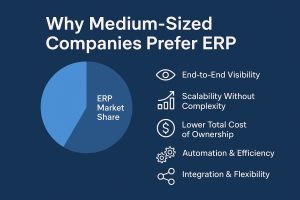In today’s rapidly evolving business environment, medium-sized companies are under growing pressure to operate with the same agility, accuracy, and visibility as large enterprises — but often with leaner teams and tighter budgets. As a result, many are turning to modern enterprise resource planning (ERP) platforms to gain a competitive edge, streamline operations, and position themselves for growth. One of the most trusted players in this space is Microsoft Dynamics 365, which has steadily expanded its market share thanks to its modular, cloud-based architecture and its ability to scale with a business’s needs.
The global ERP market is experiencing consistent growth, driven largely by digital transformation initiatives among mid-market companies. A few key trends stand out:
Cloud ERP adoption is accelerating, with more businesses moving away from legacy on-premises systems.
Mid-sized businesses account for a growing share of ERP investments, as they seek to modernize operations.
Microsoft Dynamics 365 has emerged as a leading solution in this space, thanks to its flexible deployment, integration capabilities, and strong ecosystem.
Medium-sized companies typically require robust tools but can’t always afford the heavy infrastructure and customization costs associated with enterprise-level solutions. This is where modern, cloud-based ERP platformsprovide exceptional value.
Why Medium-Sized Companies Prefer ERP
1. End-to-End Visibility Across the Business
Growing businesses often rely on multiple disconnected systems — for accounting, inventory, sales, and customer management. ERP consolidates these functions into one centralized platform.
With Dynamics 365, companies get real-time access to financial data, supply chain information, sales performance, and workforce analytics — all in one place. This level of visibility improves decision-making, forecasting, and operational control.
2. Scalability Without Complexity
Medium-sized businesses need solutions that can grow with them. Unlike rigid legacy systems, modern ERPs like Dynamics 365 offer modular functionality. Companies can start with core financials and operations, then easily add modules such as supply chain management, HR, or project operations as their business evolves.
This means no expensive rip-and-replace projects — just seamless growth.
3. Lower Total Cost of Ownership (TCO)
Cloud ERP eliminates the need for expensive hardware, servers, and in-house IT teams to manage infrastructure. With subscription-based pricing, medium-sized companies pay for what they need, when they need it, keeping costs predictable and manageable.
4. Automation & Efficiency
Manual processes slow companies down. ERP automates routine tasks — from invoice processing and inventory updates to payroll and reporting. This frees up teams to focus on strategy and growth rather than administrative work.
Dynamics 365’s AI-driven insights and automated workflows help medium-sized organizations achieve enterprise-level efficiency without enterprise-level overhead.
5. Integration & Flexibility
Medium-sized companies often use multiple tools, such as CRM systems, e-commerce platforms, or HR software. Dynamics 365 integrates natively with Microsoft 365, Power BI, and third-party applications.
This interconnectivity reduces silos, enhances collaboration, and improves reporting accuracy.
6. Security & Compliance
Data security is critical for growing businesses. Microsoft’s cloud infrastructure provides enterprise-grade security, compliance with international standards, and reliable uptime. This allows mid-sized companies to enjoy the same level of protection as global corporations — without needing a dedicated security team.
Dynamics 365 ERP Modules for Medium-Sized Companies
Dynamics 365 offers several ERP applications tailored to different business needs:
Dynamics 365 Business Central – Ideal for SMBs, covering finance, operations, sales, and customer service.
Dynamics 365 Finance – Advanced financial reporting, budgeting, and global consolidation.
Dynamics 365 Supply Chain Management – Streamlining manufacturing, inventory, and logistics.
Dynamics 365 Commerce – Omnichannel retail and e-commerce.
Dynamics 365 Project Operations – Project-based business management.
Dynamics 365 Human Resources – Comprehensive HR management.
Dynamics 365 Intelligent Order Management – Automating and managing order fulfillment.
For companies currently running legacy on-premises systems like Dynamics NAV or Dynamics GP, migrating to the cloud unlocks new capabilities and long-term cost savings.
To conclude, the ERP market is no longer dominated only by large corporations. Medium-sized companies are adopting ERP at record speed, leveraging the flexibility and affordability of modern cloud solutions like Dynamics 365. By centralizing business operations, improving efficiency, and enabling smarter decision-making, ERP systems empower mid-market organizations to compete on a global scale — without the complexity and cost of traditional enterprise IT.
The Language That Won’t Die
In an industry obsessed with the next big thing, few technologies have the endurance of COBOL. Born in 1959, COBOL (Common Business-Oriented Language) predates the internet, personal computers, and even the moon landing. And yet, it continues to power much of the world’s critical infrastructure. From banking networks and insurance claims to healthcare billing and government benefits, COBOL is not a relic—it’s a backbone. Quietly, it processes the world’s most sensitive and high-volume workloads every single day. The question isn’t why COBOL is still here. It’s why it continues to thrive—and what that means for your IT roadmap.
The Numbers Behind COBOL’s Endurance
The scale of COBOL in today’s economy is hard to ignore:
220+ billion lines of active COBOL code worldwide.
70–80% of business transactions touch COBOL at some point.
30+ billion COBOL transactions are processed every single day.
This isn’t forgotten legacy code sitting on a shelf—it’s mission-critical infrastructure. The systems that move money, settle insurance claims, process hospital records, and run manufacturing lines are still overwhelmingly written in COBOL. Why? Because replacing them isn’t simply “upgrading code.” It’s rewriting decades of embedded business rules, passing regulatory audits, retraining staff, and absorbing enormous operational risk. In a world chasing agility, COBOL survives because it delivers something rarer: predictability at scale.
Why Enterprises Still Rely on COBOL
Stability Over Novelty
COBOL systems have decades of uptime behind them. They run 24/7 with minimal failure—vital in industries where outages mean lost revenue, fines, or risks to public safety.Deep Integration
Banking settlements, claims adjudication, and logistics tracking all depend on COBOL’s tight coupling with mainframes, schedulers, and databases. Pull one piece out, and the entire workflow can collapse.The Cost Equation
A full rewrite can run into the tens of millions. Add downtime, retraining, and compliance hurdles, and the ROI is rarely favorable.Regulatory Entrenchment
COBOL systems are certified and audit-proven. Replacing them often means reopening compliance processes—a nightmare for industries like finance and healthcare.Institutional Knowledge in Code
COBOL systems encode decades of business rules, often undocumented. Replacing them means relearning your business logic from scratch—a task more cultural than technical.
Simply put: COBOL isn’t hanging on despite its age. It’s thriving because, for certain workloads, it remains the lowest-risk option available.
Where COBOL Still Reigns Supreme
Banking & Financial Services
Powers core banking, ATM networks, fraud detection, and payment rails. North American banks alone spend $11.8B annually modernizing COBOL systems.Healthcare & Insurance
Manages eligibility checks, billing, and public health programs. California’s Medi-Cal committed $220M to modernize its COBOL-based eligibility engine.Manufacturing
Runs legacy MRP systems and even production-line controllers. Modernizing a single plant line can cost $850K–$4.2M, so gradual upgrades are the norm.Government
Tax processing, unemployment benefits, and defense logistics all lean on COBOL. The U.S. GAO flagged 10 federal systems still running COBOL, costing $337M annually in upkeep.
These industries aren’t behind—they’re risk-aware. For them, COBOL is not a weakness. It’s a strategic safeguard.
The Real Risk: People, Not Code
COBOL itself works just fine. The real problem is the human layer.
The Retirement Cliff – Nearly 70% of COBOL programmers are due to retire by 2025.
Knowledge Loss – Decades of undocumented business rules risk disappearing with them.
Talent Gap – Universities don’t teach COBOL, and younger developers avoid it, citing outdated tools and limited career prospects.
This creates “human technical debt.” Even bulletproof systems become fragile if no one can maintain them. That fragility is already surfacing: during the COVID-19 crisis, some U.S. states publicly begged for COBOL programmers to keep unemployment systems afloat.
What This Means for Your IT Strategy
COBOL isn’t going anywhere soon—but your strategy around it must evolve. CIOs and CTOs face a clear challenge: how to modernize without destabilizing mission-critical systems.
Here’s the path forward:
1. Stabilize the Present
Audit COBOL systems
Automate documentation
Build failover protocols
Create knowledge-transfer programs before retirements hit
2. Build a Skills Bridge
Pair senior COBOL experts with younger developers
Incentivize COBOL upskilling internally
Use AI-powered assistants to accelerate onboarding and reduce dependency on shrinking expertise
3. Wrap, Don’t Replace
Use APIs and middleware to expose COBOL functions to modern systems
Integrate with mobile apps, cloud analytics, and AI without touching the core logic
4. Refactor Strategically
Selectively modernize high-change areas like reporting or customer interfaces
Extract business rules into decision engines for reuse in modern applications
5. Leverage AI and Emulation
Use AI-driven code converters to assist migration (with strict validation)
Run COBOL in containers or emulators for cloud flexibility and reduced mainframe dependency






